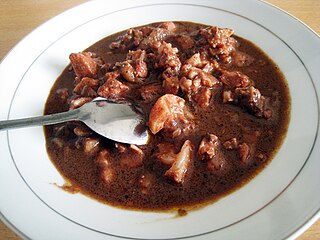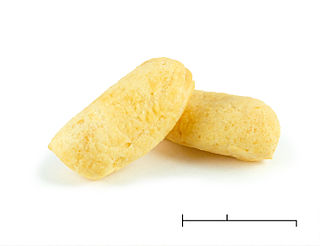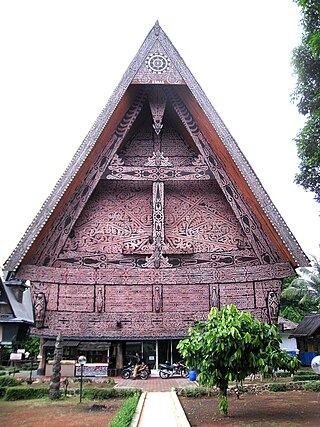Dengke mas na niura [lower-alpha 1] is a traditional Batak dish originating from the North Sumatra province of Indonesia. [2] The name of the dish means "pickled fish" in the Toba Batak language. The dish is made with raw carp which is soaked in Kaffir limes and seasoned with andaliman. [1] According to local oral tradition, only Batak kings were allowed to eat the dish, but in modern times there is no such restriction. [3]

Rendang is a Minangkabau dish. It is a rich dish of meat that has been slow cooked and braised in a coconut milk seasoned with a herb and spice mixture until the liquids evaporate and the meat turns dark brown and tender, becoming caramelized and infused with rich flavours.

Tempoyak, asam durian or pekasam is a Malay condiment made from fermented durian. It is usually consumed by the ethnic Malays in Maritime Southeast Asia, notably in Indonesia and Malaysia. Tempoyak is made by taking the flesh of durian and mixing it with some salt and kept in room temperature for three or five days for fermentation. Tempoyaks are usually made during the durian season, when the abundance of durian and excess production are made into fermented tempoyak.

The Karo, or Karonese, are a people of the Tanah Karo and part of the Karo people from North Sumatera, Indonesia. The Karo lands consist of Karo Regency, plus neighboring areas in East Aceh Regency, Langkat Regency, Dairi Regency, Simalungun Regency and Deli Serdang Regency. In addition, the cities of Binjai and Medan, both bordered by Deli Serdang Regency, contain significant Karo populations, particularly in the Padang Bulan area of Medan. The town of Sibolangit, Deli Serdang Regency in the foothills on the road from Medan to Berastagi is also a significant Karo town.

Babi panggang refers to a variety of recipes for Indonesian grilled pork dishes, 'babi' meaning pig or pork, and 'panggang' meaning grilled or roasted in the Indonesian language.

Botok or ꦧꦺꦴꦛꦺꦴꦏ꧀(Bothok) is a traditional Javanese dish made from grated coconut flesh which has been squeezed of its coconut milk, often mixed with other ingredients such as vegetables or fish, and wrapped in banana leaf and steamed. It is commonly found in Javanese people area of Java Island (Yogyakarta Special Region, Central, and East Java.

Arsik is an Indonesian spicy fish dish of the Batak Toba and Mandailing people of North Sumatra, usually using the common carp.

Saksang or sa-sang is a savory, spicy Indonesian dish from the Batak people. It is made from minced pork or dog meat stewed in its blood, coconut milk and spices; including kaffir lime and bay leaves, coriander, shallot, garlic, chili pepper and Thai pepper, lemongrass, ginger, galangal, turmeric and andaliman.
Manuk Napinadar or Chicken Napinadar is typical Batak cuisine in Indonesia that is usually served at certain customary feasts.
Na tinombur is a typical Batak dish from Tapanuli, North Sumatra, Indonesia.
Sasagun is a traditional Batak snack.

Amplang, also known as kerupuk kuku macan, is an Indonesian traditional savoury fish cracker snack commonly found in Indonesia and Malaysia. Amplang crackers are commonly made of ikan tenggiri (wahoo) or any type of Spanish mackerel, mixed with starch and other materials, and then fried.

Batak cuisine is the cuisine and cooking traditions of Batak ethnic groups, predominantly found in Northern Sumatra region, Indonesia. Batak cuisine is part of Indonesian cuisine, and compared to other Sumatran cuisine traditions, it is more indigenously preserved. One characteristic of Batak cuisine is its preference to andaliman as the main spice. That is why andaliman in Indonesia sometimes dubbed as "Batak pepper".

Krupuk (Javanese) is a cracker made from starch or animal skin and other ingredients that serve as flavouring. Most krupuk are deep fried, while some others are grilled or hot sand fried. They are a popular snack in maritime Southeast Asia, and are most closely associated with the culinary traditions of Indonesia, in particular Javanese cuisine. It is an ubiquitous staple in its country of origin, and has spread to other countries either via the migration of diaspora populations or exports.

Sop saudara is an Indonesian beef soup or buffalo soup specialty of Makassar city, South Sulawesi. The soup is commonly served with steamed rice and ikan bolu bakar.

Pindang refers to a cooking method in the Indonesian and Malay language of boiling ingredients in brine or acidic solutions. Usually employed to cook fish or egg, the technique is native to Sumatra especially in Palembang, but has spread to Java and Kalimantan. The term also could refer to a specific sour and spicy fish soup which employs seasonings like tamarind. Pindang has food preservation properties, which extends the shelf life of fish products.

Gorga is a form of artistic decoration found in the culture of Batak Toba in North Sumatra, Indonesia. The gorga motif is in the shape of flourishes and undulations. The motif is either painted or carved onto wood using three colors: white, red, black; each corresponds with different realms in the Batak Toba cosmology. Gorga motif is often found in Batak Toba architecture e.g. a Batak Toba house or objects e.g. music instruments. They are meant to protect the building or object from spiritual harm e.g. evil spirits sent from neighboring village.

Mie Gomak is a Batak thick spicy noodle soup dish served in a coconut milk and andaliman-based broth, specialty of Toba Batak region of North Sumatra, Indonesia. Other that traditional Batak lands surrounding Lake Toba, this dish is also a specialty of the Sibolga and Tapanuli area. Unlike common Indonesian noodles, the type of noodle used in this dish is a thick one called mie lidi, quite similar to spaghetti pasta, thus mie gomak is often described as Batak style spaghetti. Mie gomak is quite similar to Mie Aceh from neighbouring province.

Pekasam, Pakasam or Bekasam is a Malay term for fermented food, more precisely fermented fish product. In Malay and Banjar cookery, pekasam usually refers to freshwater fish fermented with salt, palm sugar, toasted rice grains and pieces of asam gelugur.

Kue putu mayang is an Indonesian Betawi string hopper dish made of starch or rice flour and coconut milk, then shaped like noodles. This noodle-like dish served with kinca in Betawi and Javanese cuisine, or with chutney or curry in Indian Indonesian cuisine.

Tortor is a traditional Batak dance originating from North Sumatra, Indonesia. This dance was originally a ritual and sacred dance performed at funerals, healing ceremonies, and other traditional Batak ceremonies. For the Batak people, tortor dance has both cultural and spiritual values. Through this dance, people express their hopes and prayers. Demonstrations of attitudes and feelings through this dance describe the situation and conditions that are being experienced.